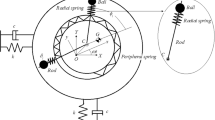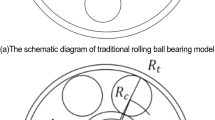Abstract
A theoretical and experimental approach was used to investigate the motion and effectiveness of a Self-Compensating Dynamic Balancer (SCDB). This is a device intended to minimize the effects of rotor imbalance and vibratory forces on a rotating system during normal operation. The basic concept of an automatic dynamic balancer has been described in many U.S. patents. The SCDB is composed of a circular disk with a groove containing massive balls and low viscosity damping fluid. The objective of this research is to, determine the motion of the balls and how this ball motion is related to the vibration of the rotating system using both theoretical and experimental methods. The equations of motion of the balls were derived by the Lagrangian method. Static and dynamic solutions were derived from the analytic model. To consider the dynamic stability of the motion, perturbation equations were investigated by two different methods: Floquet theory and direct computer simulation. On the basis of the results of the stability investigation, ball positions which result in a balance system are stable above the critical speed and unstable at critical speed and below critical speed. To determine the actual critical speed of the rotating system used in the experimental work, a modal analysis was conducted. Experimental results confirm the predicted ball positions. Based on the theoretical and experimental results, when the system operates below and near the first critical speed, the balls do not balance the system. However, when the system operates above the first critical speed the balls can balance the system.
Similar content being viewed by others
References
Alexander, J. D., 1964, “An Automatic Dynamic Blancer,”Proceeding, 2nd Southeastern Conference, pp. 415–426.
Cade, J. W., 1965, “Self-Compensating Balancing in Rotating Mechanisms,”Design News, pp. 234–239.
Den Hartog, J. P., 1956,Mechanical Vibrations, Dover, New York, pp. 225–281.
Hahn, W., 1967,Stability of Motion, Springer-Verlag, New York.
Lee, J., 1993, “Theoretical and Experimental Analysis of Self-Compensating Dynamic Balancer in a Rotating Mechanism,” Ph. D. Dissertation, Mechanical Engineering Department, University of Utah, Salt Lake City, UT 84112, U.S.A.
McGale, P.J., 1992, “Apparatus for Dynamical Balancing of Rotaing Objects and Method for Making Same,” U.S. Patent 5, 142, 936, Washington.
Nayfeh, A.H. and Mook, D.T., 1979,Nonlinear Oscillations, Wiley, New York, pp. 273–283.
Thearle, E. L., 1932, “A New Type of Dynamic-Balancing Machine,”Transactions of the ASME, Vol. 54, APM-54-12, pp. 131–141.
Notes upon Balancing High-Speed Machinery, 1904,Railway Machinery, pp. 183–184.
Author information
Authors and Affiliations
Rights and permissions
About this article
Cite this article
Lee, J. Theoretical and experimental motion analysis of Self-Compensating Dynamic Balancer. KSME Journal 9, 167–176 (1995). https://doi.org/10.1007/BF02953618
Received:
Issue Date:
DOI: https://doi.org/10.1007/BF02953618




